

|
Back to |
| The Front Page |
| News & Features |

|
British croquet - in the words and pictures of England's own Liz Taylor
|
|
||||||
|
Paintings, sketches, and annotations by Liz Taylor Posted August 28, 1998 |
|||||||
Liz Taylor-Webb began playing croquet in the 70's, but it was not until 1985 that croquet became a frequent subject of her paintings and drawings. Since then, she has become perhaps the sport's best known illustrator, with croquet paintings and drawings in numerous private collections, galleries, and museums. Showing us some of her favorite venues, she explains how croquet and art have come to coexist so happily in her eternally bright English summer. All the paintings are acrylic, and the drawings are detailed pencil work printed as limited editions.
Stroll through our Digital Art Gallery to get a better view.
THE ROAD TO CROQUET
The Southport Croquet Club in Lancashire, founded in 1895, is one of the largest in Britain, with nine lawns and a lovely old clubhouse. Although its tournament does not always attract the top English players, it nevertheless has twelve club teams from the North West competing in Open and handicap singles and doubles events.
The town of Southport is a holiday resort on the coast, and there is a public footpath from the club down onto the beach. Non-playing spouses often have picnics in view of the croquet games or go with the children down to the beach.
I did not play in this particular tournament; instead I sat on the sidelines with a glass of wine, sandwiches, and my sketch book.
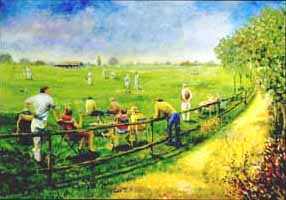
"The Road to Croquet" [better view]
FINALS MATCH
I painted this picture after being impressed by the electric, silent atmosphere of the nail-biting final match of the first ever international between England and South Africa in 1995 at my club, Bowdon. The intense quiet of the onlookers remained imprinted on my mind. Although extremely competitive in the U.K., croquet has a relaxed and happy atmosphere surrounding the game. (Fortunately, England won 7-5.)
Bowdon Croquet Club in Cheshire was founded in 1873, and croquet has been played here continually, apart from the war years, and we now have almost full membership of 100 players.
Members serve afternoon tea and cakes every Saturday, which ensures that they will come along and socialise as well as play the game. We have four lawns and a wooden club house built in 1911. The lawns are regarded as among the finest in England, ensuring prestigious national and international competitions - the most recent being the Solomon Trophy played in July, '98, between England and America.
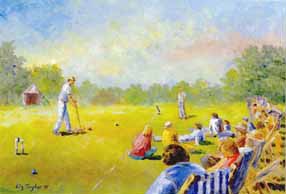
"Finals Match" [better view]
THE FIRST WORLD CROQUET CHAMPIONSHIPS, 1989, AT HURLINGHAM
I watched the very first World Championships at Hurlingham in 1989. Fantastic atmosphere! I sat in a players' tent with a continuous supply of ice-cold Pymms and just sketched all day.
This picture was used on the cover of the publicity flier produced by Hurlingham in conjunction with the world championship. It has been purchased by the National Croquet Gallery in Newport, Rhode Island, where it hangs today in the Newport Art Museum.
To quote from the flier, "There are few more traditional scenes than a garden party in the grounds of a large English house. It conjures up visions of warm, balmy afternoons, cucumber sandwiches and silver teapots....From across the lawns the crack of the croquet mallet sends a ball scuttling towards the rhododendrons....Hurlingham is one of London's finest Georgian mansions and provides the ideal backdrop [for the World Croquet Championships} with its sweeping lawns, the towering chestnut and cedar trees, the colorful rose-beds and the resplendent peacocks. It is the most perfect setting for mid-summer events."
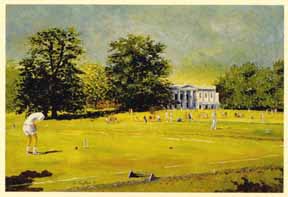
"The First World Croquet Championships, 1989, at Hurlingham" [better view]
THE HURLINGHAM CLUB
I drew this picture the very first time I played at Hurlingham in 1981. The ambience was overwhelming, the weather perfect. White-coated waiters were servmg tea out on the terraces; a small orchestra was playing Viennese music. I was awe-struck.
I stayed in the household of a dear friend of mine, Robin Godby. He was Chairman of the Croquet Association at the time, and his is the figure I have drawn in the foreground playing on lawn number four, directly in front of the clubhouse. The man in the seat opposite is Colonel D.M.C. Prichard, author of "The History of Croquet'", who had come over to watch the game. It is a fact that all the great names in croquet of this century have found their way to the ten hallowed lawns of Hurlingham - the sport's Mecca.
Later I was asked to have the picture printed into Christmas cards, the proceeds from which were given to my home club, Bowdon, struggling for financial survival at the time.
The picture is in the collection of Brian Storey and is shown by his kind permission.

"The Hurlingham Club" [better view]
A SLOW GAME
To play croquet at Hurlingham, the headquarters of British croquet, is to experience the game at its elegant and genteel best. Imagine the scene in the summer every Sunday afternoon: There is a palm court orchestra playing out on the terrace, people having tea outside watching the various sporting activities or drinking Pymms in the rose garden. The River Thames flows just feet away from the lawns. The tents in the picture are a distinctive blue and white stripe, standing out among the ten croquet greens and an abundance of trees and shrubs.
This particular occasion was the annual week tournament in August. The man in play - who shall be nameless - took a very long time deliberating each shot; when he came to the hoop nearby, he was amazed to see his opponent fast asleep, much to the amusement of onlookers. It was a scene I just had to capture.
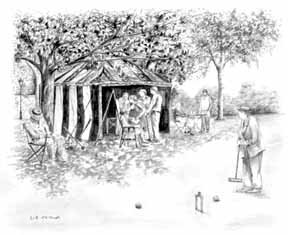
"A Slow Game" [better view]
CRITICAL DECISION
This scene took place at a summer tournament at Wrest Park Croquet Club in Bedfordshire. It is open to anyone from any club to enter, and people come from all over Britain to play here.
Although the decision could win or lose the game for the worried-looking player, the opponent has already made up his mind - hence the smile - and he is anxious to get back onto the lawn.
Wrest Park is a huge ancestral estate in the style of a French chateau, built in 1834, home to the family of the Earl de Grey. Alas, when they failed to produce an heir to the family early this century, the house and gardens were sold, now comprising an agricultural college and research institute. There are 90 acres of magnificent formal gardens, and it is here that Wrest Park Croquet Club is situated, with its six croquet lawns.
In the background can be seen strollers exploring the extensive gardens, which include lakes and beautiful summer houses.
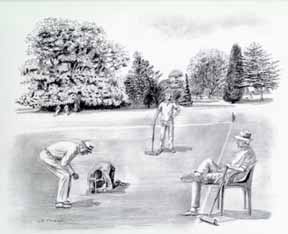
"Critical Decision" [better view]
ORMESBY HALL
Ormesby Hall Croquet Club Teeside is in the North East of England, set in the beautiful grounds of Ormesby Hall, a huge ancestral home dating back to the middle of the 18th century, surrounded by more than 3,000 acres of landscape gardens and farmland. The original house was built in 1600; the Hall was built in 1740 by the Pennyman family. Ormesby Hall remained the family seat until as recently as 1983, when it passed to the National Trust.
The last time I was there, I played in a Northern League match between Ormesby Hall and Bowdon - it was a long way to go to lose!
The picture shows part of the walled gardens on the right which are open to the public, who often stop to watch the croquet during their tour of the estate.
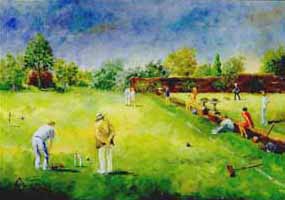
"Ormesby Hall" [better view]
WAITING A TURN
I was inspired to do this painting after spending a couple of hours in Manchester City Art Gallery browsing blissfiilly among the pictures. There was a painting by 19th century artist Marcus Stone that depicted a man sitting in a garden, waiting his turn to speak to a lovely young Lady.
As I studied the picture, it reminded me of all the times a croquet player waits in the garden for his turn in the game. I came home and started to work on my painting the same night. When I look at it I try to imagine what was in the mind of Marcus Stone in 1891 when he painted his man waiting for his turn in quite another game.
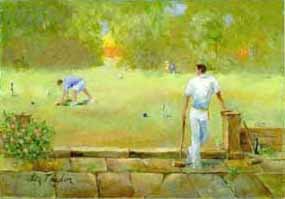
"Waiting a Turn" [better view]
ABOUT THE ARTIST
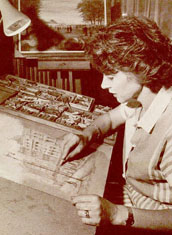 With a name like Liz Taylor, it helps to have a sense of humour. Happily, the
English Liz Taylor has this in abundance. And as someone recently commented,
"She's an extrovert and a half." But to find the real Liz Taylor, take a
close look at her art. Her approach to scenes is affectionate and highly
individual. Above all, she is a student of life - and it shows.
With a name like Liz Taylor, it helps to have a sense of humour. Happily, the
English Liz Taylor has this in abundance. And as someone recently commented,
"She's an extrovert and a half." But to find the real Liz Taylor, take a
close look at her art. Her approach to scenes is affectionate and highly
individual. Above all, she is a student of life - and it shows.
Her time at Rochdale College of Art and several years spent developing her skills led, in 1974, to the first of dozens of exhibitions as a professional artist, including her 1981 showing at the famous Gallerie Moulin de La Gallette in Paris.
She has executed a number of private commissions, many of them for large public companies, and her work is now published in print form by one of the largest art publishers. She also produces original prints and greeting cards "for people who want something a little different."
Liz Taylor has played croquet at the Bowden Croquet Club for nearly 20 years, and has a current handicap of five. In the past, she has competed in the Barlow Bowl - for the best six women in the country - but now she plays mostly in club competitions and in tournaments throughout the country. Hurlingham - where she has won various handicap events - is her favorite croquet venue.
It was shortly after she married her husband Rupert Webb in 1984 that Liz Taylor-Webb began to paint croquet pictures. The couple live happily in Wilmslow Cheshire.
[These art works in this article may not be reproduced in any form without the express permission of the owners.]